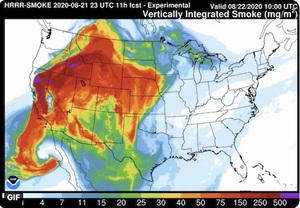Congratulations to our GSL team for successfully transitioning significant upgrades to NOAA regional hourly-updating weather models into NWS operations!

The NOAA National Centers for Environmental Prediction (NCEP) transitioned the final versions of GSL-developed NOAA's flagship high-resolution weather models -- Rapid Refresh (RAP) and High-Resolution Rapid Refresh (HRRR) into operations. This latest RAP/HRRR version includes upgrades that make forecasts better in nearly all aspects including the upper atmosphere, surface, clouds, precipitation, and thunderstorms. Specifically, model upgrades improve forecasts in the Great Lakes region by coupling to a model with lake hydrodynamics, produce wildfire-driven smoke forecasts and predict the impact of smoke on the weather via the HRRR-Smoke module, and assimilate storm-scale ensemble data.
These versions also have an enhanced physics suite that improves how the model depicts clouds smaller than 3km and their effect on the local environment and how terrain impacts horizontal flow. GSL scientists have optimized the RAP code to make a 48-hour forecast in the same amount of time it previously took to produce a 36-hour forecast. This model implementation includes RAP-Smoke, HRRR-Smoke and HRRR-Alaska.
This final configuration of these RAP/HRRR model systems will serve as a baseline as NOAA transitions to a regional convection-allowing application in the Unified Forecast System, known as the Rapid Refresh Forecast System (RRFS). The RAP/HRRR implementation is a shining example of technology from NOAA Research, and a significant step in meeting NOAA's mission for improved environmental weather forecast guidance.
NOAA's Earth System Research Laboratories (ESRL)/Global Systems Laboratory (GSL) led and worked collaboratively with a talented team to develop and refine the RAP and HRRR models. Key players are NOAA's NWS including NCEP, NOAA's cooperative institute partners, the Cooperative Institute for Research in Environmental Sciences (the University of Colorado Boulder) and the Cooperative Institute for Research in the Atmosphere (Colorado State University, Fort Collins), the Federal Aviation Administration, the National Center for Atmospheric Research (NCAR), and the Department of Energy.
Congratulations to the GSL Team!
Data Assimilation: Curtis Alexander, Amanda Back, Stan Benjamin, David Dowell, Jeff Duda, Guoqing Ge, Ming Hu, Eric James, Terra Ladwig, Haidao Lin, Hongli Wang, Steve Weygandt
Model Physics/Chemistry: Ravan Ahmadov, Hannah Barnes, Stan Benjamin, John Brown, Georg Grell, Siwei He, Jaymes Kenyon, Joe Olson, Tanya Smirnova, Mike Toy, Greg Thompson (NCAR)
Model Assessment/Verification: Trevor Alcott, Jason English, Venita Hagerty, Jeff Hamilton, Brian Jamison, Bill Moninger, Randy Pierce, Molly Smith, Bonny Strong, Ed Szoke, Dave Turner
Retrospectives Execution: Trevor Alcott, David Dowell, Jason English, Eric James, Jaymes Kenyon, Terra Ladwig
WCOSS Parallel Maintenance and Support: David Dowell, Ming Hu, Sam Trahan
Management: Curtis Alexander, Melinda Marquis

